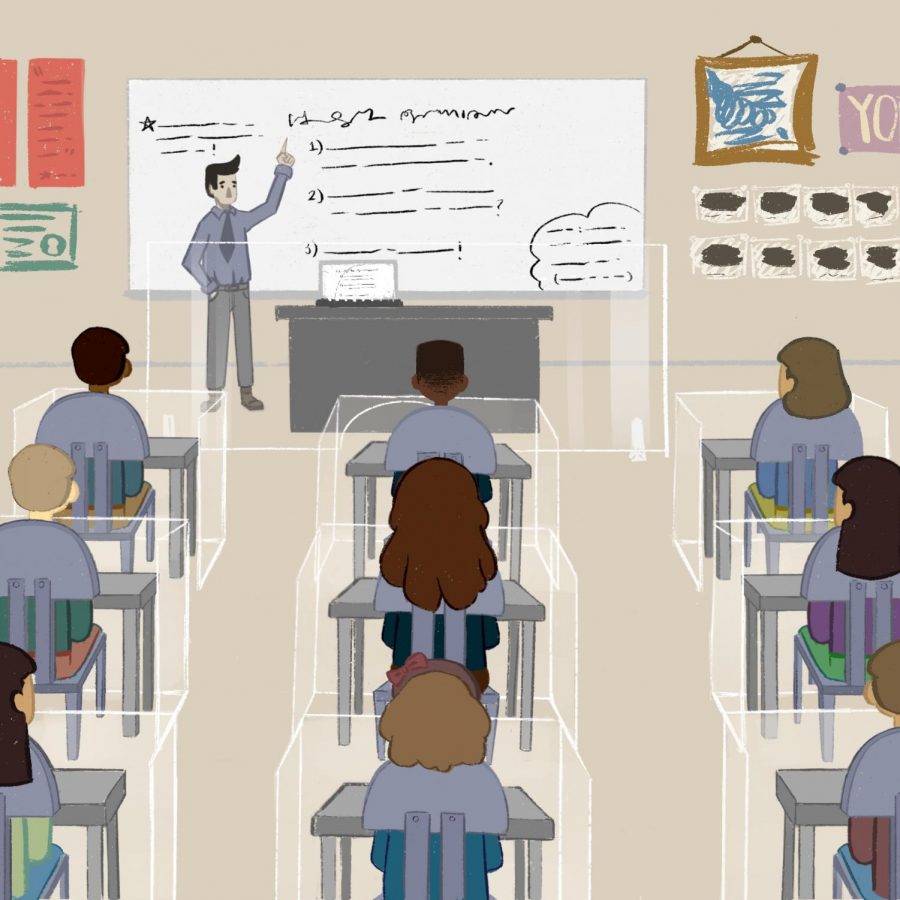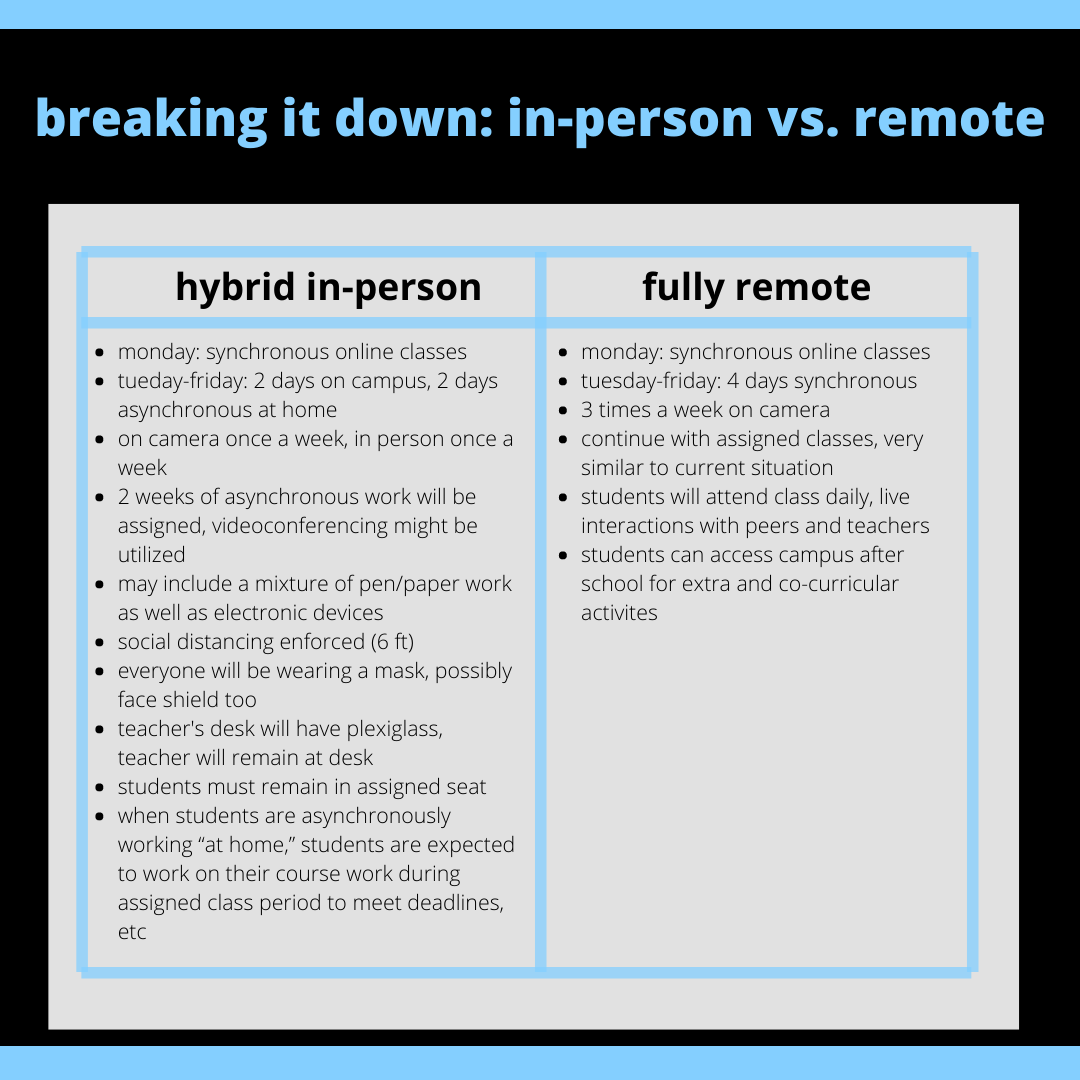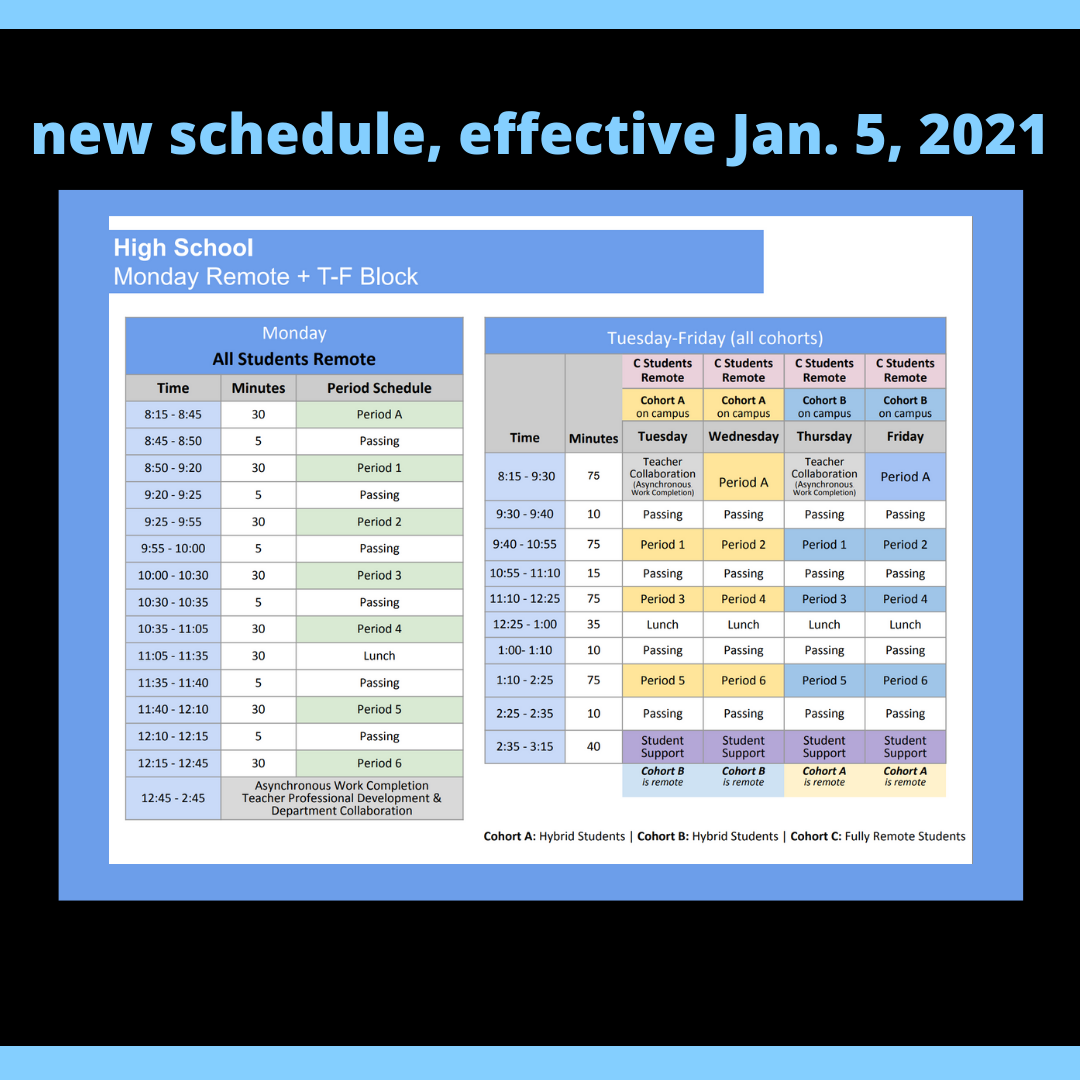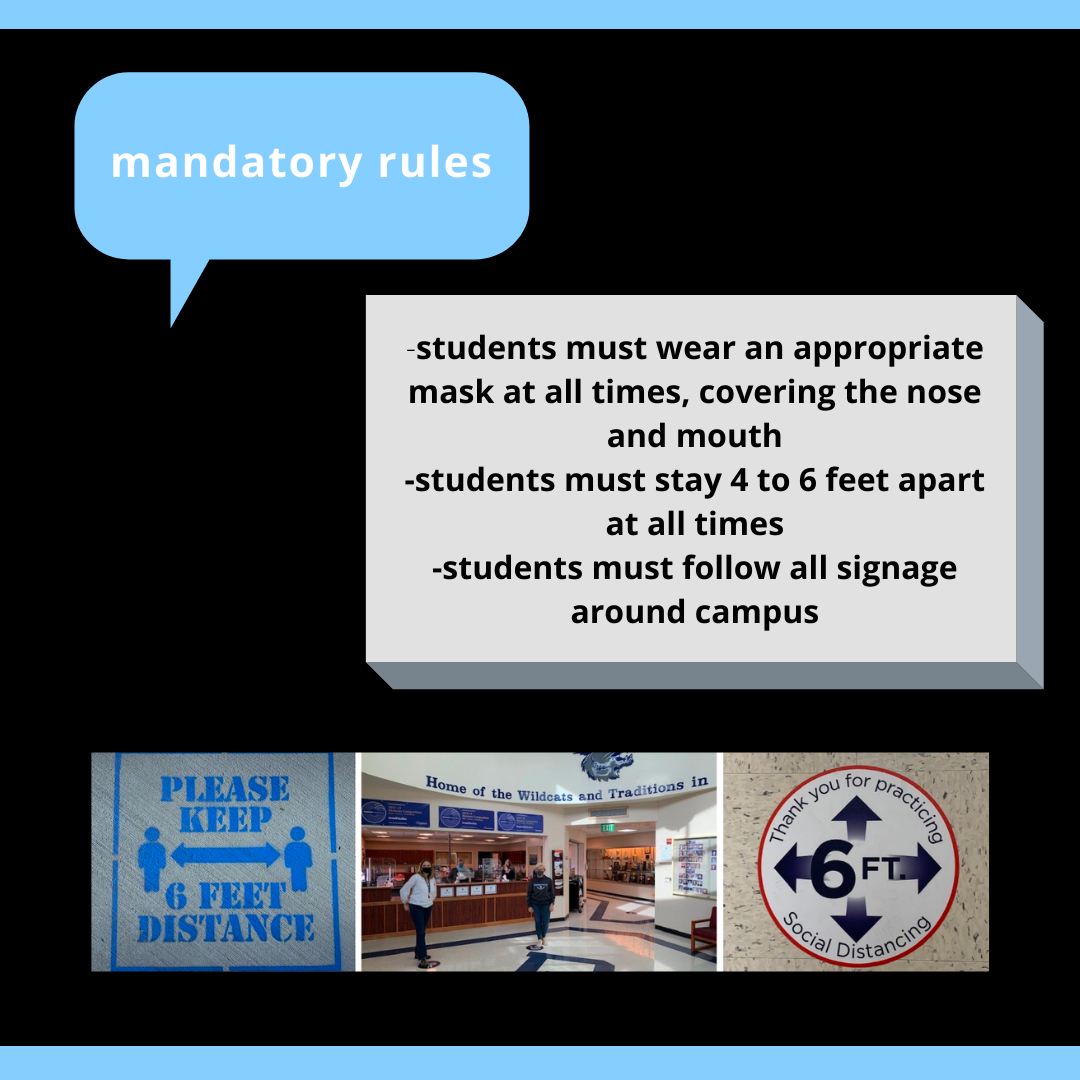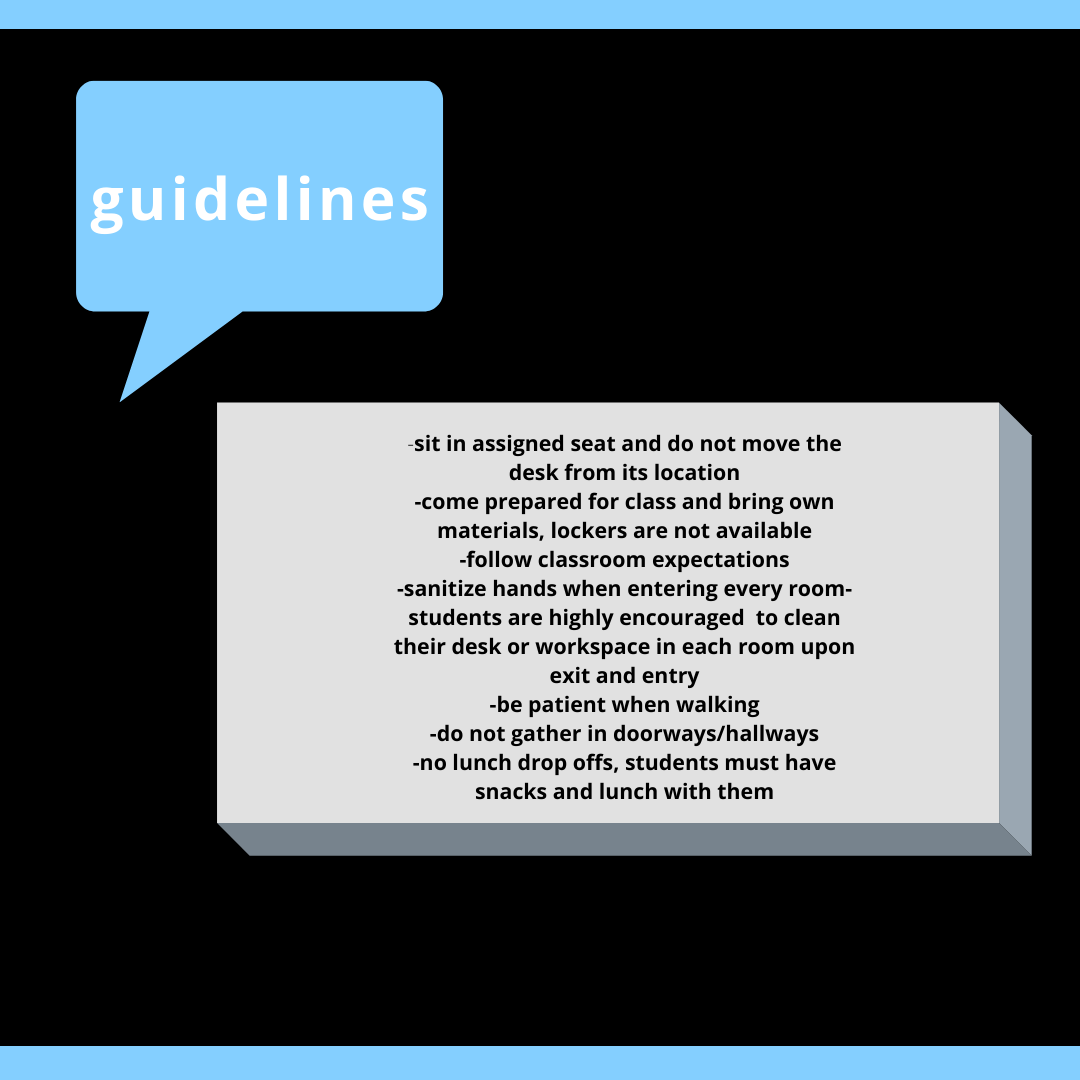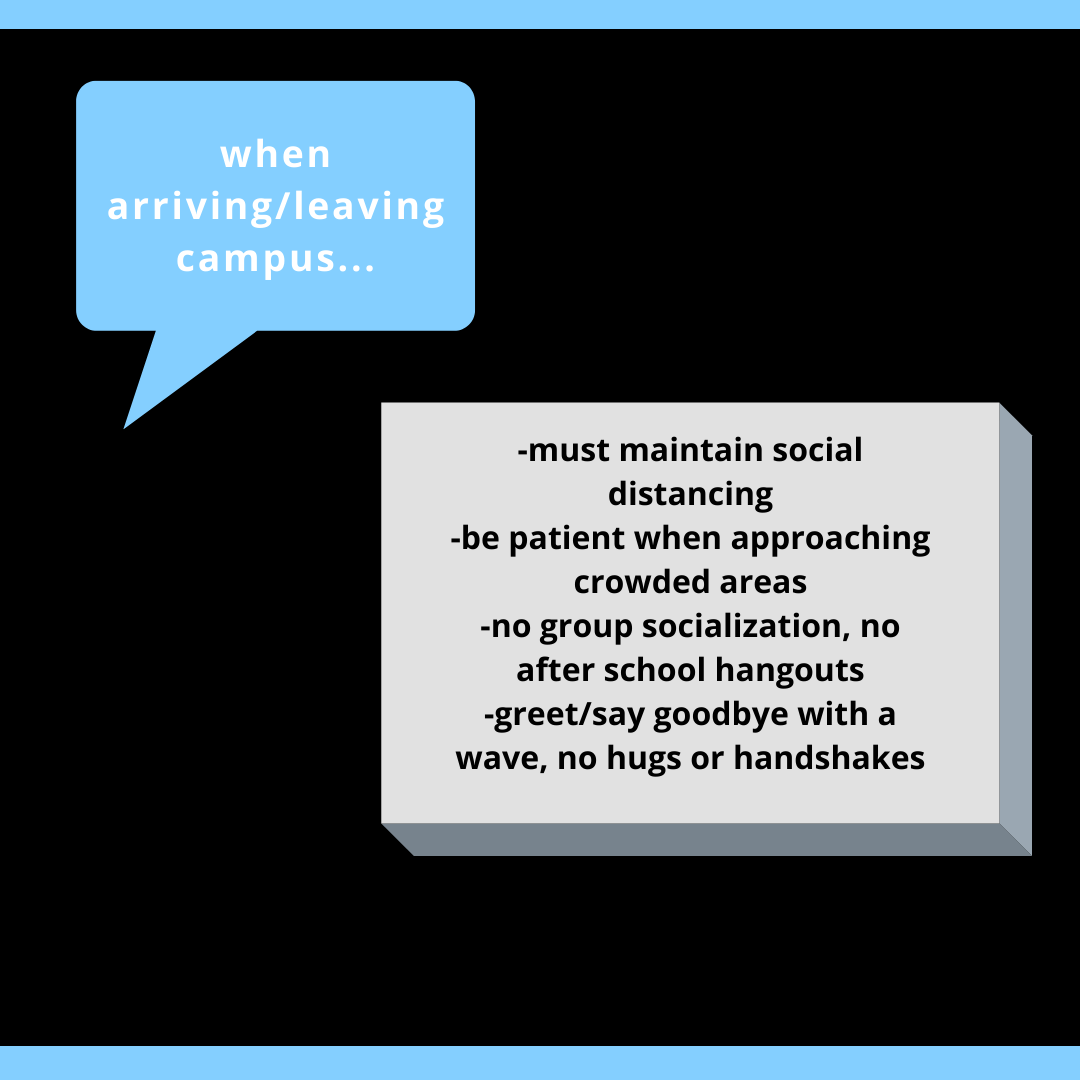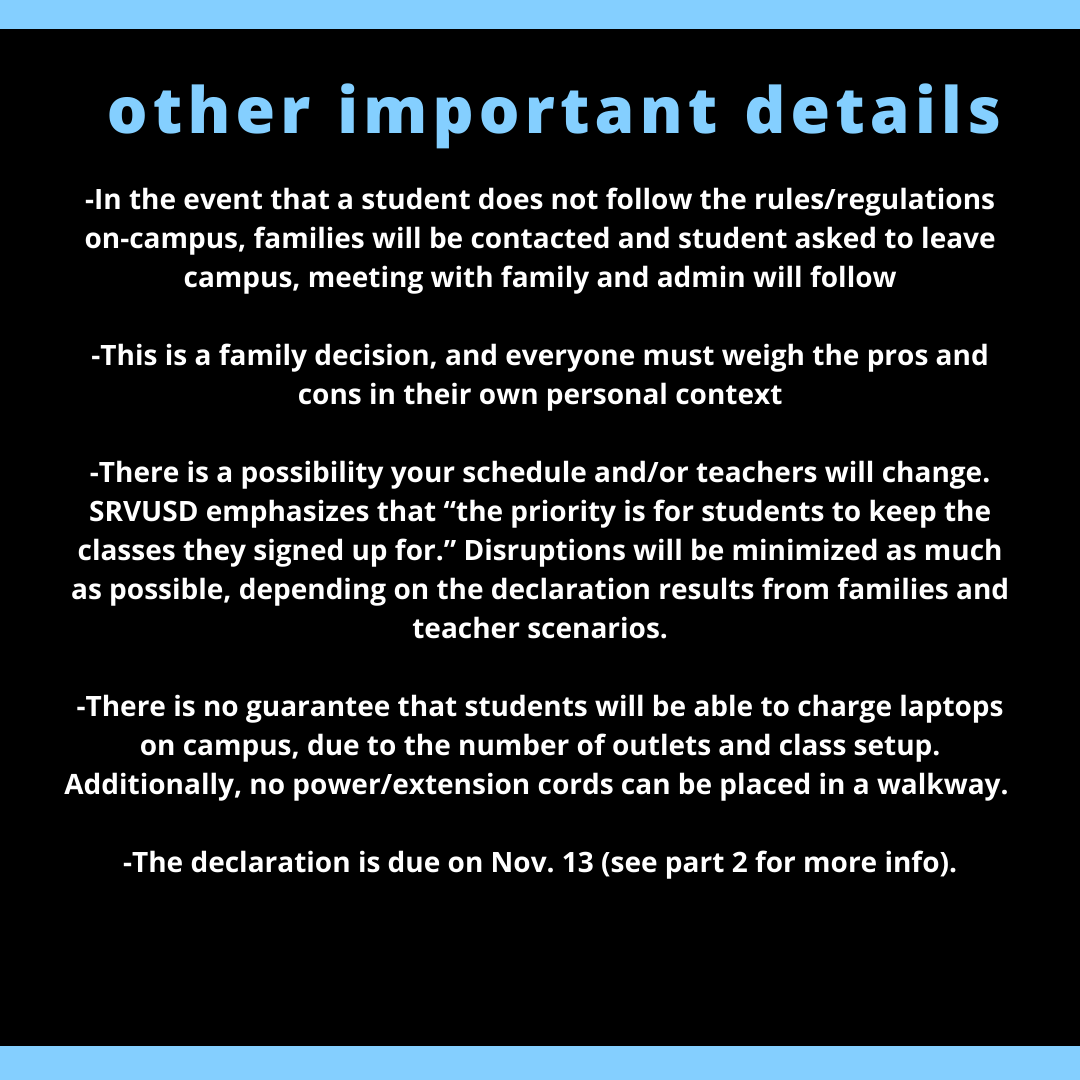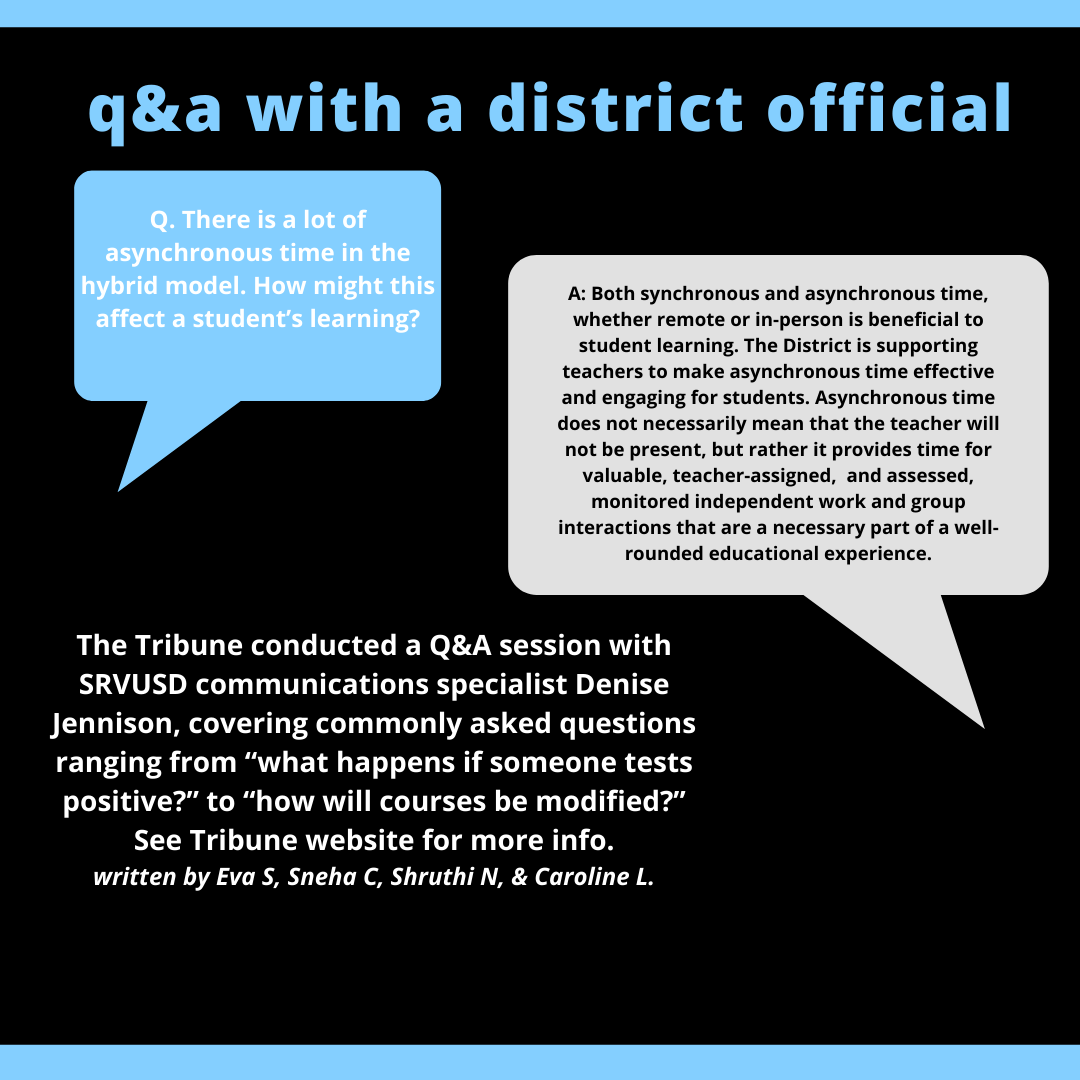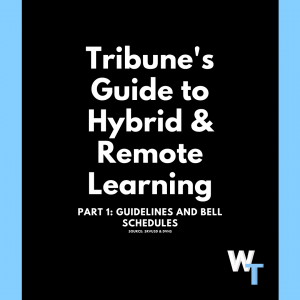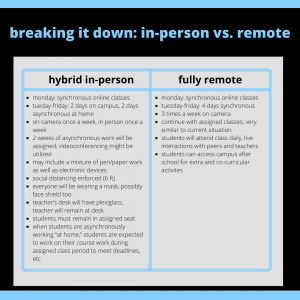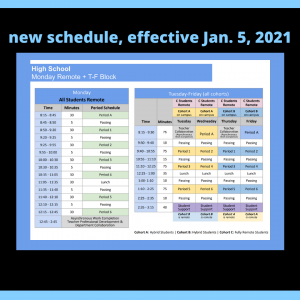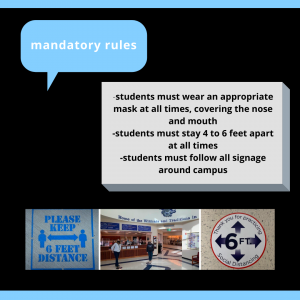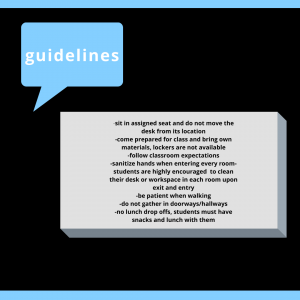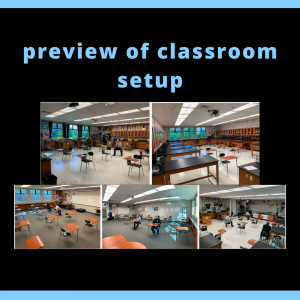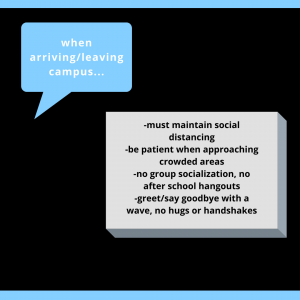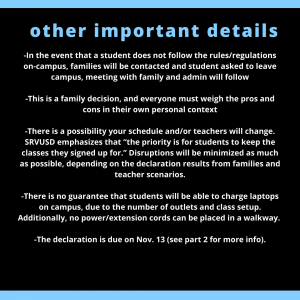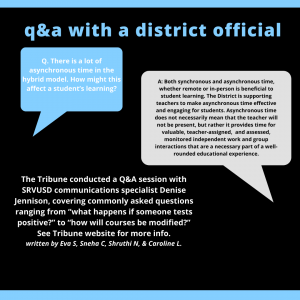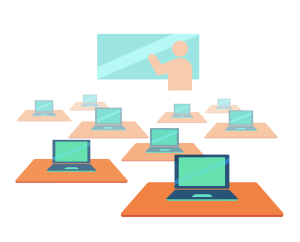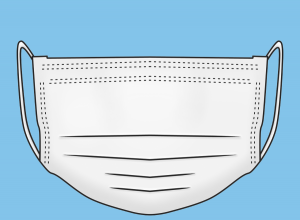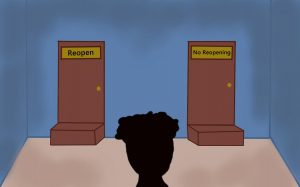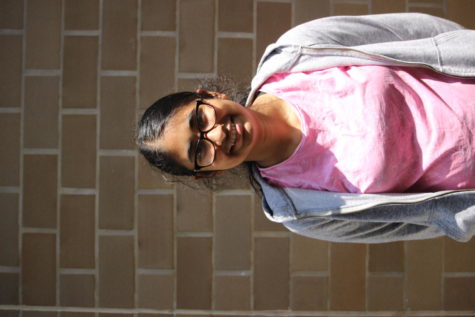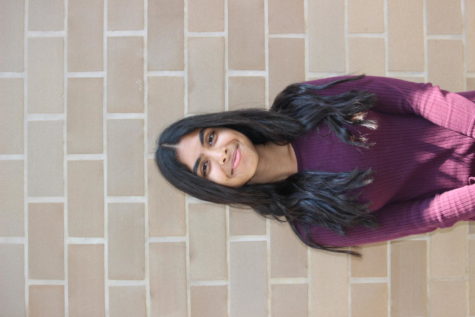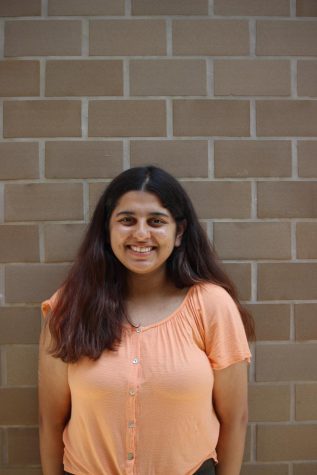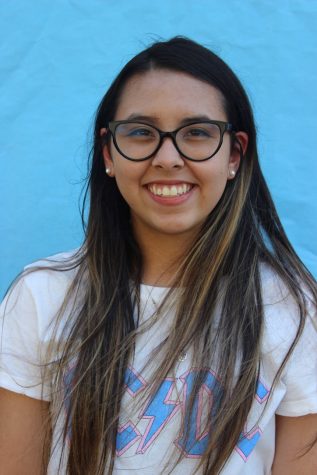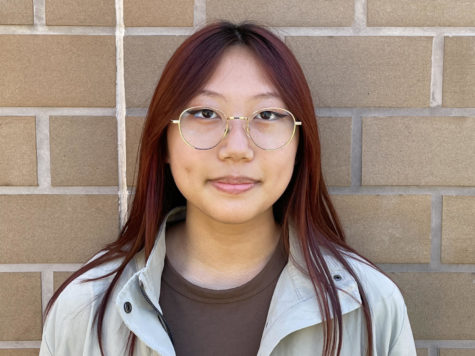SRVUSD: Hybrid learning set to begin in January
SRVUSD has released a new hybrid plan to start next semester in conjunction with virtual learning.
December 3, 2020
Note: As of Nov. 17, Contra Costa has moved to the purple tier in regards to COVID cases. However, per an SRVUSD press release dated Nov. 16, “SRVUSD’s plan to reopen schools is not being impacted” and “in consultation with Dr. Farnitano, we are being allowed to proceed with Phase 2 of our reopening plan.” We will update this story if changes occur.
SRVUSD announced at a Sept. 29 board meeting that schools across all levels would reopen for hybrid learning in January. At the time, there was little information offered about the plan besides that it would involve a shortened schedule and two cohorts of students returning to school. The Board also announced that a virtual learning option would still be available for students who didn’t want to return to school. However, more information on Phase 2 of SRVUSD’s reopening plan is now available.
Logistical updates, rules and statements from SRVUSD
SRVUSD has updated their Guide to Reopening on Nov. 6 and DVHS has sent Dougherty-specific return to campus information to student and parent emails on Nov. 9. Some of the most important takeaways are as follows:
In levels KG- 6, a classroom will consist of 14 students and one-two teacher cohorts, with staff tested every one to two months.
Students and staff members will be required to wear a face mask at all given times. Two cloth masks will be provided, with the addition of having disposable masks at each given school site. Teachers will be required to wear a face shield as well. If a student has a medical/disability concern, they are asked to speak to the school nurse in regards to mask regulations. [if a student is hard of hearing or in speech therapy, they may be able to substitute their face shield with a mask- however, it is necessary to contact the school before doing so.] All students are additionally asked to bring a bag to keep their masks safe when allowed to remove [snack breaks].
All students are mandated to fill out the system check every morning at home before school starts. If a student answers yes to any of the questions, it is trivial that they do not go on campus.
It is recommended for students to eat a full-hearted breakfast before coming to school to avoid being hungry; with this being said, grab-and-go meals will be available for free to students under the age of 18.
All classrooms will be primarily vacant except for desks and some learning supplies; each class will be frequently sanitized after each cohort leaves and trash will be thrown out at the end of every day. Students are asked to clean all learning supplies [ones given from school and brought to home] before coming to class. Students are additionally advised to bring their own materials to avoid the spread; this includes books, writing utensils, technology etc. If unable to do so, it will be provided by the school; however, the student will need to clean it on their own.
A six feet distance between each body is required and visual aids along with other measures will be implemented in order to maintain hygiene and practice social distancing. Hand sanitizers along with hand washing stations will be available among all school campuses; this will be part of the daily schedule, which consists of putting it on after or before using PPE, between classes, entering or exiting classes, food breaks, etc.
A ventilation system will be put in place and includes open windows, improved air filtration,ongoing ventilation, constant maintenance of the system and making sure it is ventilating while cleaning. Plexiglas barriers will be on public-facing countertops in the main office.
In regards to having to deliver or drop papers off at school, a mail drop-off system will be put in place.
The schedule for Secondary education [grades 6-12] will consist of 75 minute block periods for high school students and 70 minute for middle schoolers. There will be two cohorts, Cohort A which will be attending school Tuesdays and Wednesdays in person andCohort B, which will be Thursdays and Fridays; on the days students do not have assigned to come to school, they will be given asynchronous activities to work on. Monday will be a full remote day for both cohorts. There will be no lockers in place and all students are required to follow social distancing at all times. A mask must be worn during passing period and in the hallways.
In regards to remote learning, students may expect not much change to what is happening right now. Asynchronous learning will be continued for 5 days a week. Teachers and schedules may be interrupted or changed, but the current bell schedule will be planned to be followed.
For special education remote learning, all IEP (Individualized Education Program) services will remain based on the health guidelines stated in the IEP. More information about special education remote learning can be found on the SRVUSD website. For special education services on campus, aids will help out in the classroom if the teacher is remote; however, all other services will be provided per usual. IEPs will be implemented remotely; however, assessments will take place in-person with parental consent. All paraeducators and teachers will have safety gear (face shields, masks, gowns, gloves, etc.).
In regards to transportation services, all students must be wearing a mask and use hand sanitizer before entering the bus. All students will have assigned seating and will enter and exit in a straight line.
Specialized small groups are allowed to come to campus for one hour a day maximum for intervention, socialization, or enrichment. These groups are offered no matter the COVID tier status or at school’s discretion. If they want to stay on campus for longer, they need to talk to administration.
There will be two nurse’s rooms per site — a room for people showing symptoms of COVID-19 and a room for people with other, general health concerns. In the COVID-19 room, if a student has COVID-19 or shows symptoms, they will be given a mask, told to social distance, asked about their symptoms, asked about their potential exposure to COVID-19, and they will be evaluated. After that, they will remain in the room until their parents or an emergency contact picks them up within 30 minutes. The general health room will be for situations not related to COVID-19 (ex: injury, medication, bleeding, etc.). Students cannot rest in the general health room; if they show any symptoms of any illness, they need to go directly to the COVID-19 sick room. This includes headaches and stomachaches. Students need to talk to teachers and nurses about specific anxiety-related symptoms. Minor injuries (like cuts) will be handled in classrooms — each classroom has its own first aid kits with Band-Aids, etc. Standard immunization rules will apply, see the California Health Departments Shots for School site for more information.
Drop-off procedures will stay the same: parents must wear a mask and social distance if they will be walking their student(s) to the campus entrance. Parents should stay in their vehicle while picking up their student(s). If picking up in-person, parents must wear a mask, social distance, and wait in front of the school. If they want to pick up their student(s) early, they need to call the school office from their car and then, their student will report to the front entrance. Every school has different traffic flow patterns with marked entrances and exits, and these will be shared by the principal at a later date. No visitors will be allowed unless they had previously made an appointment. If a student forgets something at home, someone is not allowed to drop it out.
For extracurriculars, there is a waiver form that families need to fill out. These extracurriculars include sports, arts, and other clubs. These involve small, stable cohorts that are socially distanced. These cohorts are only Mondays to Fridays after-school. Specific details will be revealed by individual programs. More information will be given later for non-school related groups (sports leagues, religious groups, etc.)
SRVUSD, student, and teacher perspectives
Superintendent John Malloy said that it was difficult to make a decision on this issue as people all across the district have varying perspectives on this issue, as some people want students to go back to in-person school immediately while others would prefer if the whole school year remained virtual.
Tanaaz Ahamed, a junior at Dougherty Valley, shares her concerns for going back to school. “The reason I am staying at home is because I feel it is the best choice for me. A second wave may be coming soon, in which the school will shut down anyway. If I do end up going to school, I fear people not using their masks correctly and failing to maintain social distancing.”
Trying to cater to everyone’s individual needs is a challenge. Malloy stated that per a survey with a 55% response rate, 32% of students want to return to school in a hybrid model, 31% want to stay remote for the rest of the year, 18% want to consider this for January, 9% didn’t care as long as they kept their teacher, and 8% were unsure. “We don’t even have any agreement within our community, so that means we run the risk of everyone being upset with us.”
SRVUSD is also well aware of the fluctuating circumstances and lack of clarity surrounding the pandemic and its implications on schools, raising questions if returning is even a feasible option. Malloy articulated “People are asking, is it better to come back under these circumstances or not? That is a matter of opinion as well.”
“We want to minimize all disruptions…you’re getting used to your teachers. You understand their expectations, you have your classmates, and even if you’re studying with them like this, I get to see all your faces and expressions,” Malloy stated. “But what happens if we are all so far apart? And trouble is, whenever we make a change to where we are now to the next place, which is a hybrid model, some kids may always choose to be remote. The problem is, we might have to change things.”
Another concern many have proposed is student mental health. Malloy emphasized, “What makes this question even more challenging as people ask me all the time was, are the risks greater if we stay home? Or are the risk greater if we come back related to mental health? And I would say it’s dependent upon the student.”
Malloy, who is also a trained counselor, spoke to this issue. “Some kids have told us, they’re fine. They’re connecting with their friends, they’ve got their small bubble. Their parents are okay with who they’re hanging out with, because everybody’s being really careful and cautious. And they’re fine. Other kids are telling us they’re not.”
He also emphasizes the need for students to reach out and communicate to trusted adults about their mental health, regardless of the situation. “What we want to communicate to our students is, if you’re having any stress, any struggle, please talk to your parents, to your teacher, to your counselor, please, because that’s the way we’re going to be able to help, even if we are still in a remote environment.”
Student interactions also remain a point of contention. Neesa Pathikar, a junior at DVHS voices her worry about student interactions [with peers and the teacher.] “I am concerned how students are going to learn and ask teacher questions, if both the students and the teachers are required to stay at their desk- in terms of a test the student has no privacy at all in order to ask their question. Another concern is how there will be no allowance for group projects which can hinder a students social skills by not allowing them to work with others.”
Despite varying feedback, these decisions aren’t made lightly. Malloy spoke to the Tribune on the district’s priorities: “[First, we need to keep everybody safe]. Number two, providing good learning, effective instruction, helping kids succeed. And number three, we know that we got to pay attention to mental health and wellness. Some of you might be doing better, at home, in your room, learning, studying. [And some might be the opposite].”
In the last few weeks, the plan has been revised. Right now, the current plan is to have one teacher stand at the front of the classroom, teaching to both students who are in-person and students who are virtual at the same time. This plan has raised a myriad of questions, ranging from how students will remain separated during passing periods to how effective it would be for teachers to teach to both in-person kids and virtual kids at the same time.
SRVUSD is taking safe and restrictive measures in order to open safely, as they have much personal protection equipment (PPE) on board. These include over 1.7 million blue surgical masks, over 200,000 sets of gloves, over 100,000 surgical gowns, and over 10,000 gallons of hand sanitizer. Malloy emphasized that “we have a warehouse full of PPE for everyone,” and teachers will not be expected to pay for anything out of pocket. Additionally, the district has employed over 125 full time and professionally trained custodians in order to disinfect and maintain the sites daily.
In the wake of sudden changes brought on because of the COVID-19 pandemic, the district has made a number of decisions to adapt to these changes, and this new decision to go hybrid in January is one of them.
It is important to note, with the fluctuating situation of the virus, many things are up to change. It is paramount to look out for emails from SRVUSD frequently in order to stay up to date on the updated version of the new hybrid plan. Visit the Reopening Together webpage here.

